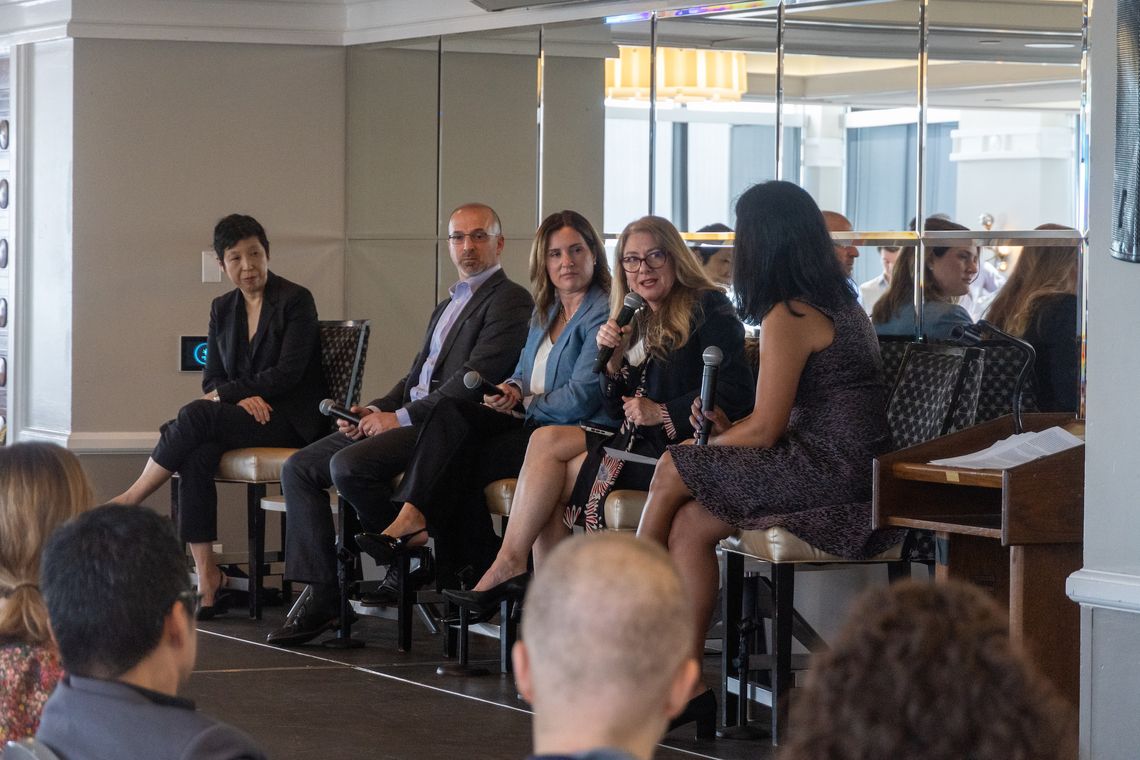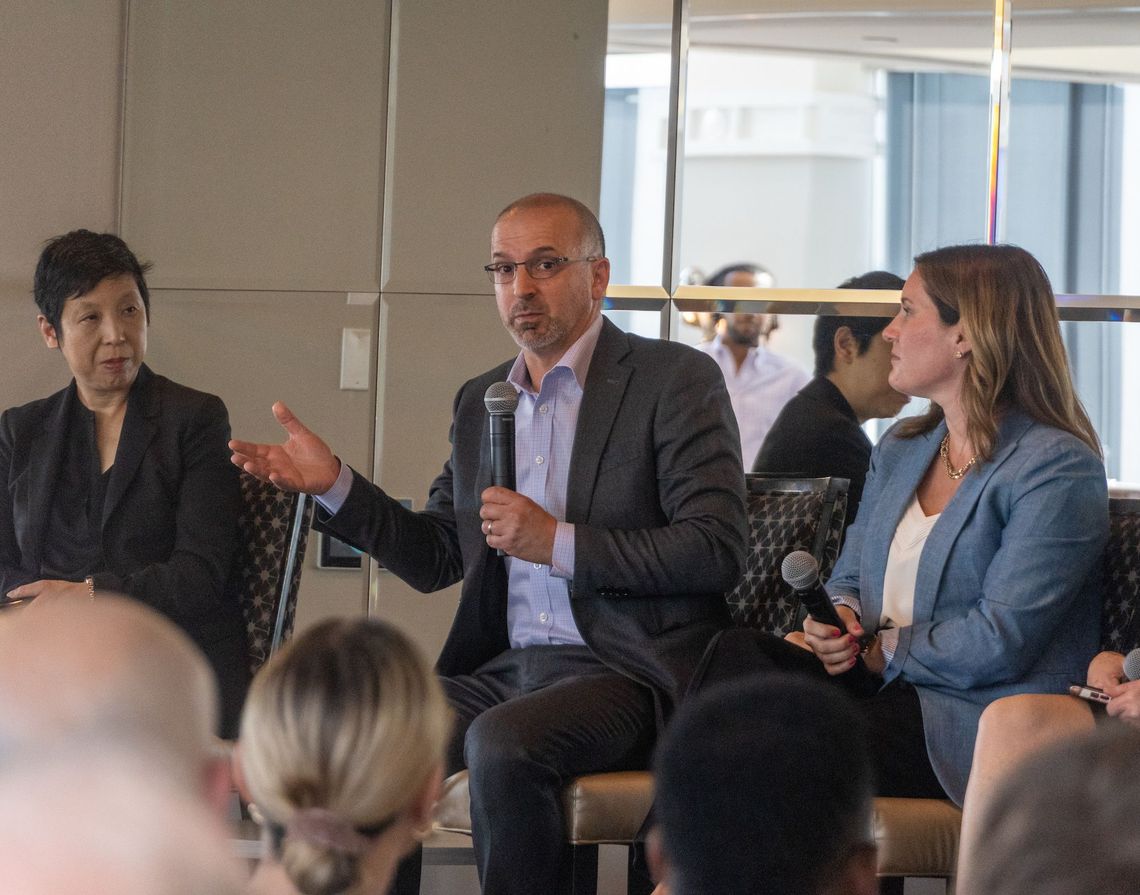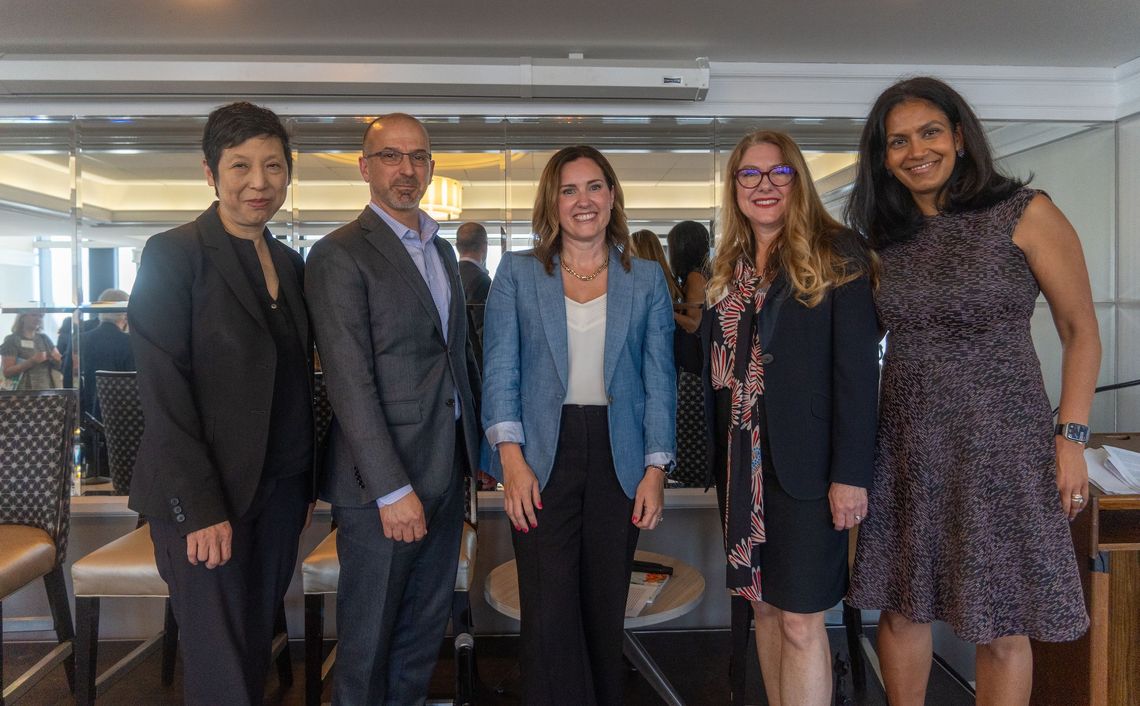
blog
The State of Center City, Philadelphia in 2024: A Recap of the May 2024 CPDC Meeting
"Perhaps it’s time to stop talking about recovery and instead work to conjure the downtown that we want and that our city needs."
Center City District's CEO Prema Katari Gupta, along with VP Clint Randall and Economic Development Managers Jimmy Salfiti and Lauren Smith, presented the State of Center City Philadelphia 2024 report, focusing on downtown vitality and investment drivers. Afterward, industry leaders across sectors discussed sustaining Center City's strength and reinforcing and accelerating positive trends.
Panelists:
- Brian Berson, President, Parkway Commercial Properties, Inc.
- Crystal Brewe, Executive Vice President and Chief Marketing and Audience Experience Officer, Ensemble Arts Philly
- Liz Smith, Chief of Staff, SEPTA
- Ellen Yin, Founder and Co-Owner, High Street Hospitality Group
The following presents an overview of several pivotal themes explored during the discussion. Additionally, discover how you can become a member of CPDC to gain access to these exclusive conversations.
Key Statistics from the Report
- 43% of all Philadelphia’s jobs are located in Center City
- 24,800 jobs were added in 2023 citywide, taking unemployment to a 30-year low
- 18% decrease in crime within CCD boundaries since 2019
- 45% of employees who work in the West Market office district lived within 5 miles of work in 2023, compared to only 1/3 of workers in 2019
- Center City is one of the fastest growing areas in the city with its population growing by 26% in the past 20 years, and an increase of 11,000 residents since 2020.
Reimagining Downtown Amidst Shifting Demographics and Perceptions

The panel featured leaders from real estate, transportation, the arts and hospitality and focused on the topics of shifting audience demographics and demands, employee retention, and revitalizing the downtown in a new era.
“We’re in the age of convenience,” Crystal Brewe from Ensemble Arts Philly stated during the panel, highlighting a generational and cultural shift. As long-time members are aging, Brewe and her team are catering to younger audiences and marketing events as if they are “the event of the year” given that more patrons are buying single tickets instead of yearly memberships.
Liz Smith, Chief of Staff at SEPTA, pointed out how convenience and ease-of-use are critical to encourage public transit ridership. SEPTA’s new wayfinding and rebranding strategy and expanded payment options aim to make public transit easier to navigate for new audiences, including non-native English speakers, tourists and ad-hoc riders.
Noting the generational shift, Ellen Yin of High Street Hospitality Group remarked that “younger crowds really want an experience, and they're willing to pay for that experience.” Additionally, while people are eating earlier compared to the late-night dining trends of the past, restaurants continue to be booked and tables filled. Foot traffic statistics from the State of Center City 2024 support Yin’s observations, showing that more people are downtown on the weekends than in 2019. While behaviors have shifted, foot traffic and restaurant data demonstrate that people in the region continue to seek community, connection and culture downtown.
Retaining Talent by Prioritizing Office Flexibility
Brian Berson of Parkway Commercial Properties, however, had a different outlook on convenience from the employer’s perspective: “what drives the growth or…competitiveness of your company is not going to be convenience. It's going to be talent,” emphasizing the point that cities are where “the best and the brightest come together.”
Ellen Yin concurred with Brian Berson’s point, highlighting that in the restaurant industry, one of the biggest challenges is attracting top talent. Compared to the suburbs, the city has a competitive edge: “everybody's always asking me to open a restaurant in the suburbs. But every restaurateur in the suburbs is always complaining that there is no talent in the suburbs.” In Ellen’s experience, talent seeks amenities, and amenities are in the city. To Berson’s point that city employers tend to focus on talent and suburban ones on convenience, Gupta offered, “why not both?”, pointing out that with the clustering of talent and amenities in and around Center City, people and companies thinking about downtown can benefit from both.

Given the importance of talent to a successful downtown, the conversation shifted to strategies to retain top talent in the office and beyond. For modern employees, a more flexible workplace is a primary motivator to success and retention at work. Arguments on how to increase employee retention include providing more in-office amenities, improving the quality of public education, and cultivating intra-office flexibility for a better work-life balance.
“Culture will eat strategy for breakfast" stressed Brewe, encouraging employers to reflect on cultivating a work culture that motivates employees to be there. At SEPTA, Smith creates a culture of work-life balance by following through on that herself, asserting that leaders must set an example by embracing flexibility and work-life balance themselves. For Smith, and many others on the panel, a more flexible work schedule means she does not have to choose between her family and her job, allowing her to attend doctor’s appointments and her child’s sporting events while still successfully contributing to company objectives.
As work, family, and social life become more blended, flexibility in the workplace is key to building a better city.
A Call to Action: What if We Get it Right?

As we reimagine life post-COVID, promoting the city as an important meeting ground for people to come together again is paramount to retaining vitality and competitiveness. In pursuit of this goal, Gupta concluded the panel by inquiring how we, as an audience, can contribute.
"Zoom culture has created this need for connection and cities are a place where connection happens. That is why the hospitality industry, culture, and all those things are so important."
— Ellen Yin, High Street Hospitality Group
Non-profit organizations, Ensemble Arts and SEPTA, note that their teams must provide top-tier services with limited resources. Brewe stated that, as a non-profit, “you have to compete at the same level that our audiences are experiencing at private companies like Disney.” While funding is still needed, promotion goes a long way. In both returning to the office and attracting patrons, Brewe noted how impactful sharing positive experiences can be: “FOMO works really well…just share about all the great things that you’re experiencing in Center City everywhere you can.”
Smith echoed the importance of sharing positive experiences in combating the false perception that public transit is unsafe. In fact, data supports that it is extraordinarily safe: “less than 1% of major crime in the city of Philadelphia occurs in or around SEPTA’s property” (Liz Smith). For public transportation, the arts, and hospitality alike, creating the downtown that we want and that our city needs requires cultivating new, positive perceptions.
Panelists were optimistic about the future. Several ideas for bolstering the city were generated from the conversation, including sharing one’s experiences on social media, providing welcome packets to new residents that introduce local businesses, offering more family-friendly programming, and opening more public green spaces to encourage visitors to spend more time downtown. On the employee side, intra-office flexibility and collaborative office policies to support work-life integration were key themes throughout the discussion. The wide array of ideas proposed across sectors underscores a collective commitment to enhancing the city's vibrancy and fostering a more inclusive and attractive environment for residents and employees alike.

How You Can Get Involved

“With 43% of Philadelphia’s jobs located in Center City, it is critical that we continue to play an outsized role in creating opportunity for all Philadelphians,” Gupta concluded at the end of the State of Center City presentation. “We can continue to will our cities to resume the patterns of the last decade, or we can really learn, and try to create a better downtown.”
To learn more about the trends discussed, check out our annual report, The State of Center City Philadelphia 2024. Interested in hearing the perspectives of other business leaders? Learn how you can become a member of the Central Philadelphia Development Corporation and attend our member-only panels.